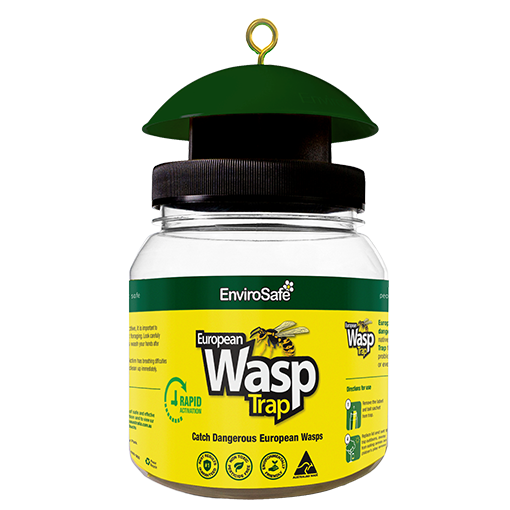European Wasps can be difficult to control in residential areas. They build nests underground and forage widely around them, so you may have wasps entering your property, but their source, the nest, may be quite some distance away. If a nest has been identified, it can be destroyed by a trained specialist (get advice from your local council or pest control company), however, if the nest has not been found, the next best thing is to trap the foragers when they enter your property.
The EnviroSafe European Wasp Trap and Bait is a convenient solution to annoying European Wasp foragers that find their way into your garden or outdoor eating area. This Australian-made product has been developed and tested under Australian conditions and is highly attractive to foraging European Wasps.
Setting the trap
- Set up the trap by pouring the powdered bait from the sachet into the empty trap and adding water to approximately 1/3 of the height of the trap. Give the trap a swirl to assist with the suspension of the powder in the water. The water can be cool or luke-warm but should not be hot.
- The bait is highly attractive to wasps, so to avoid wasps flying around you as you hang the trap, it is best to prepare and hang the trap early in the morning before the wasps become active. European Wasps return to their nest at night and will emerge to resume foraging in the morning as the day starts to warm up.

Where to hang the trap
- If you have European Wasps regularly visiting your property (for example to feed on pet food, fruit trees, flowers or water), take note of the direction in which the wasps are coming and going. They generally tend to fly directly to and from the nest when foraging. If possible, hang the trap along that flight path to attract the wasps into the trap before they reach their usual foraging site. Set the trap in a prominent position so the wasps have no problem locating it.
- The simplest method of hanging the trap is to slip it onto a pergola hook. Alternatively, garden tie-wire or twine can be used to firmly fix the trap to a tree branch, fence or other structure so that it has no chance of being blown down.
- It is important to set the trap at a height which will avoid the risk of children or pets reaching it. When disturbed, European Wasps can sting repeatedly, and some people can have a severe allergic reaction to the wasp venom, especially if they have been stung several times. If stung, clean the area with soap and warm water and apply a cold pack to reduce swelling and pain. Be alert for signs of severe allergic reaction and call an ambulance (000) if there are any symptoms other than local inflammation and redness.

Trap maintenance and disposal of dead wasps
- The trap should need very little maintenance. If conditions are hot and you notice that the water is evaporating quickly, add a little more water to the trap without opening it by simply directing a hose into the holes at the top of the trap. It is important that the trap is 1/3 full of water to keep the bait moist and to drown the wasps after they have entered the trap.
- If the trap starts to attract too many flies, you may want to pour the bait through a sieve into a temporary container, then dispose of the captured insects, and then pour the bait back into the trap to continue trapping for a bit longer.
- After week or two, you will want to empty the trap and re-set it with a new bait as the decaying insects will start to attract flies. Early in the morning, check the trap to ensure that all of the trapped wasps are dead (if not, the trap is still working and could be left there for a while longer). We recommend environmentally friendly disposal methods if possible. If you have a compost bin, the trap contents can be tipped into that. Otherwise, you could pour off the liquid and tip the captured insects into a compostable bag (eg, kitchen caddy bag) and place it in your green organics kerbside collection bin, or if necessary, the general waste bin. Be careful not to touch wasps even if they are dead because the stinger mechanism can deliver a sting for some time after death.

